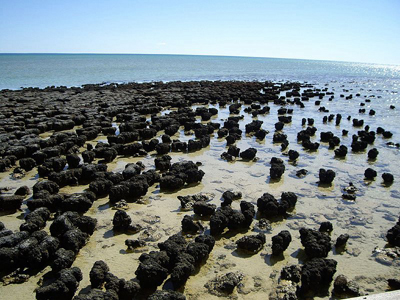Share this page:
Shark Bay is a World Heritage listed site on the coast of Western Australia. It is the westernmost place in Australia and is famous for Monkey Mia, a spot where, most days, a family of bottlenose dolphins swims in to meet people and get a free meal of fish to eat.
Shark Bay actually consists of two lagoons -- the Freycinet Estuary and the Hamelin Pool -- which are separated by long, thin strips of land.
Shark Bay has earned its World Heritage listing due to its unique ecological value. Of particular interest ecologically are the numerous stromatolites found in Hamelin Pool, Shark Bay.

Stromatolites in Hamelin Pool, Shark Bay, WA
(Photo: Happy Little Nomad)
Stromatolites (coming from the Ancient Greek words for "layered rock") are dome-shaped structures (they look a bit like cauliflowers and a bit like rocks) built by millions of microbes (called cyanobacteria, or blue-green algae). Tehy are believed to be the world's oldest living organisms. They trap sediment and photosynthesize energy from the sun, creating oxygen. Stromatolites are very similar to -- and are descended from -- ancient life forms that were on the earth up to 3.5 billion years ago. In fact until they were found in Shark Bay in 1953, scientists had only seen such structures before in fossils.
Looking at Hamelin Pool and its stromatolites is a suggestion of what the world may have looked like 3.5 billion years ago when stromatolites were already widespread.
Stromatolites (and the similar ancient life forms that they are descended from) have been an essential part of contributing oxygen to the earth's atmosphere and to the development of oxygen-breathing organisms on the earth.
Other natural and ecological attractions of Shark Bay include some wonderful beaches and some sea-grass beds. One place to see all of these marvels is the François Perron National Park, just north of Monkey Mia and Denham.
The earliest European to visit the Shark Bay area was the Dutch navigator, Dirk Hartog, in 1616 (his visit was only the second by a European anywhere in Australia, Dutchman Willem Janszoon having visited the Gulf of Carpentaria in 1605). He landed on Dirk Hartog Island and nailed up a pewter plate (bearing his name and the year 1616).
Amazingly, eighty years later, in 1696, the plate was found half buried in the sand on the island by passing Dutch explorer Willem de Vlamingh who took the plate back to Amsterdam, Netherlands, where it may now be seen in the Rijksmuseum.
The inscription on Hartog plate (translated from the Dutch) reads:
1616. On the 25th October the ship Eendracht of Amsterdam arrived here. Upper merchant Gilles Miebais of Luick (Liege); skipper Dirck Hatichs (Dirk Hartog) of Amsterdam. On the 27th ditto we sail for Bantum. Under merchant Jan Stins; upper steerman Pieter Doores of Bil (Brielle). In the year 1616.
A replica of the Hartog plate may be seen in the Geraldton Museum in Geraldton, WA.
The main town in the Shark Bay area is Denham, located the Peron Peninsula, one of those strips of land mentioned above. Once a pearling town (like Broome), Denham's main industries are now prawning and tourism.
Share this page:
Author: David Paul Wagner
(David Paul Wagner on Google+)
|